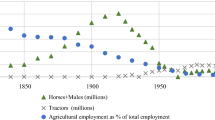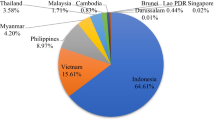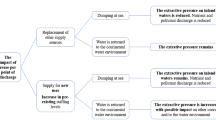Abstract
Commercial aquaculture in India has come under attack for having caused negative agricultural and environmental impacts. This paper formulates an interactive model of non-renewable and renewable resources to characterize land allocations between aquaculture and agriculture in ecologically and economically sustainable fashion. Through an empirical application, various economic and policy circumstances that affect the optimal land allocation mix are evaluated. The aquaculture industry must address two economic effects: off-site negative effects on renewable food and other coastal resources, and on-site self-pollution of shrimp ponds. Current regulatory and land-use policies are inadequate to address these effects.
Similar content being viewed by others
References
Alagaraswamy, K. (1995), Current Status of Aquaculture in India: The Present Phase of Development and Future Growth. The Report of the Regional Study and Workshop on the Environmental Assessment and Management of Aquaculture Development. Rome: FAO.
Assadi, M. (1995), 'Karnataka's New Agricultural Policy: Making Way for Corporate Land Lordism',Economic and Political Weekly 30, December 30
Ayres, A. D. and H. E. Hayward (1949), Proceedings of Soil Science Society of America 13, 224-226.
Balan, B., N. Sukumaran and R. Suresh (1996), 'Economics of Semi-Intensive Shrimp Farming in Tuticorin', Seafood Export Journal 27(8), 17-19.
Bhartiya, M. T. (1996), 'Aquaculture Industry: A Review', Seafood Export Journal 27(11), 5-8.
Bhatta, R. and M. Bhat (1998), 'Impacts of Aquaculture on the Management of Estuaries in India', Environmental Conservation 25(2), 109-121.
Boyd, C. E. (1997), 'Shrimp Farming and the Environment', MPEDA Newsletter 11(6), 14-22.
Central Marine Fisheries Research Institute (1995), Marine Fisheries Information Service. T&E Service, No. 136, January-March Issue, Cochin, India.
Barbier, E. B. and I. Strand (1998), 'Valuing Mangrove-Fishery Linkages: A Case Study of Campeche, Mexico', Environmental and Resource Economics 12, 151-166.
Browdy, C., A. Stokes, J. Hopkins and P. Sandifer (1997), 'Improving Sustainability of Shrimp Pond Water Resource Utilization', in Proceedings of The Third Annual Ecuadorian Aquaculture Conference, CENAIM-ESPOL-CAN, Guayaquil, Ecuador.
Csavas, I. (1995), 'Development of Shrimp Farming with Special Reference to Southeast Asia', Fishing Chimes 15(1), 33-43.
Department of Agriculture (1996), Personal communication with the Department of Agriculture, Government of Karnataka, Kumta, India.
Flaherty, M. and C. Karnjanakesorn (1995), 'Marine Shrimp Aquaculture and Natural Resource Degradation in Thailand', Environmental Management 19(1), 27-37.
Government of Karnataka (1961), Karnataka Land Reforms Act, 1961. Bangalore, India: Government of Karnataka, p. 25.
Government of Karnataka (1995), Karnataka Land Reforms (Amendment) Act, 1995. Bangalore, India: Government of Karnataka, p. 5.
Hausenbuiller, R. L. (1978), Soil Science: Principles and Practices. Dubuque, Iowa: WM. C. Brown Company.
Just, R. E., D. Zilberman, E. Hochman and Z. B. Shira (1990), 'Input Allocation in Multicrop Systems,' American Journal of Agricultural Economics 72.
Kahn, J. R. and W. M. Kemp (1985), 'Economic Losses Associated with the Degradation of an Ecosystem: The Case of Submerged Aquatic Vegetation in Chesapeake Bay', Journal of Environmental Economics and Management 12, 246-263.
Krishnan, M., T. Ravisankar, P. S. P. Gupta, D. D. Vimala and K. Gopinathan (1995), 'The Economics of Production of Brackishwater Aquaculture in Krishna District of Andra Pradesh', Seafood Export Journal 26(8), 19-25.
Landesmann, L. (1994), 'Negative Impacts of Coastal Aquaculture Development', World Aquaculture 25(2), 12-17.
Leber, K. and G. Pruder (1988), 'Using Experimental Microcosms in Shrimp Research: the Growth Enhancing Effect of Shrimp Pond Water', Journal of World Aquaculture Society 19, 197-203.
Macintosh, D. J. and M. J. Phillips (1992), 'Environmental Considerations in Shrimp Farming', Infofish International 6, 38-42.
Mesterton-Gibbons, M. (1988), 'On the Optimal Policy for Combining Harvesting of Predator and Prey,' Natural Resource Modeling 3, 63-90.
Ministry of Environment and Forests (1997), Notification dated February 6, 1997. New Delhi, India: Ministry of Environment and Forests, Government of India.
Moschini, G. (1989), 'Normal Inputs and Joint Production with Allocatable Fixed Factors', American Journal of Agricultural Economics 71, 1021-1024.
National Environmental Engineering Research Institute (1995), Inspection Report on Impacts of Aquaculture Farming and Remedial Measures in Ecologically Fragile Coastal Areas in the States of Andra Pradesh and Tamil Nadu. Nagpur, India, p. 84.
Parks, P. J. and M. Bonifaz (1994), 'Nonsustainable Use of Renewable Resources: Mangrove Deforestation and Mariculture in Ecuador', Marine Resource Economics 9, 1-18.
Patil, P. G. and M. Krishnan (1997), 'The Kandaleru Shrimp Farming Industry and Its Impacts on the Rural Economy: An Empirical Analysis', Agricultural Economics Research Review 10(2), 293-308.
Porter, R. (1984), 'The Optimal Timing of an Exhaustible Reversible Wilderness Development Project', Land Economics 60(3), 247-254.
Santhana-Krishnan, G. (1995), 'Indian Aquaculture in the 21st Century Prospects and the Perspectives for Sustainable Development', Seafood Export Journal 26(3), 5-13.
Shiva, V. and G. Karir (1997), Towards Sustainable Aquaculture: Chenmmeenkettu. New Delhi, India: Research Foundation for Science, Technology and Ecology, A-60 Hauz Khas.
Srinath, K., M. Sridhar, P. N. R. Kartha and A. N. Mohanan (2000), 'Group Farming for Sustainable Aquaculture', Ocean and Coastal Management 43(7), 557-571.
Stanley, D. L. (2000), 'The Economics of the Adoption of BMPs: The Case of Mariculture Water Management', Ecological Economics 35(2), 145-155.
Stevenson, N. J. (1997), 'Disused Shrimp Ponds: Options for Redevelopment ofMangroves', Coastal Management 25, 425-435.
Strand, I. E. (1990), 'Interaction between Agriculture and Fisheries: Empirical Evidence and Policy Implication', in R. E. Just and N. E. Bockstael, eds., Commodity and Resource Policies in Agricultural Systems. New York: Springer-Verlag.
Suthawan, S. (1997), Economic Valuation of Mangroves and the Roles of Local Communities in the Conservation of the Resources: Case Study of Sural Thani, South of Thailand. Final report submitted to the Economy and Environment Program for Southeast Asia (EEPSEA). Singapore: EEPSEA.
Swallow, S. K. (1990), 'Depletion of the Environmental Basis for Renewable Resources: The Economics of Interdependent Renewable and Nonrenewable Resources', Journal of Environmental Economics and Management 19, 281-296.
Swierbinski, J. E. and R. Mendelsohn (1989), 'Exploration and Exhaustible Resources: The Microfoundations of Aggregate Models', International Economic Review 30, 175-186.
Takayama, A. (1985). Mathematical Economics (2nd edn.). New York: Cambridge University Press.
Teixeira, S. (2002). The Sustainability of Aquaculture in Trinidad and Tobago: A Case Study of the Country of St. Patrick. Masters Thesis, Florida International University, Miami, Florida, USA.
The Brackishwater Farmers Development Agency (BFDA) (1996), Personal communication with BFDA, Government of Karnataka, Karwar, India.
The Economic Times(1996), 'SC Orders Demolition of Prawn Farms to Bail out Fishermen', New Delhi, India, December 12, pp. 1-26.
Venkatesan, V. (1996), 'Current Status of Coastal Aquaculture Industry in India and Scope for Further Capital Investment and Technical Collaboration', MPEDA Newsletter 1(15), 10-15.
Author information
Authors and Affiliations
Corresponding author
Rights and permissions
About this article
Cite this article
Bhat, M.G., Bhatta, R. Considering Aquacultural Externality in Coastal Land Allocation Decisions in India. Environmental and Resource Economics 29, 1–20 (2004). https://doi.org/10.1023/B:EARE.0000035424.64335.6d
Issue Date:
DOI: https://doi.org/10.1023/B:EARE.0000035424.64335.6d




